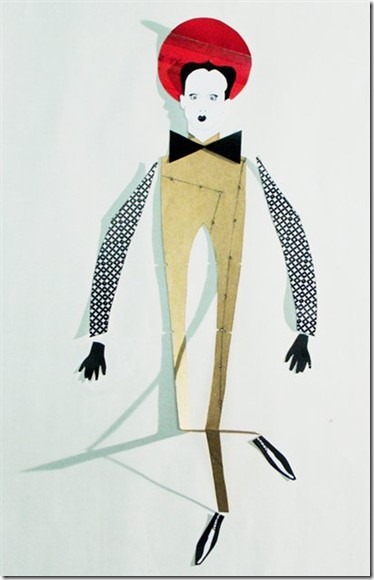Discarded suit patterns from dead Savile Row customers form the foundation of the Hormazd Narielwalla’s PhD student’s work.
Article by Lily Bonesco | DAZED Digital
Hormazd Narielwalla is about to finish his PhD at London College of Fashion whilst having published two books, completed a residency on Savile Row and exhibited his tailor-based artwork worldwide. His book ‘Dead Man’s Patterns’ has been even been noted by Paul Smith. However, Narielwalla remains touchingly modest despite all this success. This is enhanced by his genuine interest in the work he creates, which ranges from fashion illustration to abstract collage: all linked by his delicate style and the tailoring patterns he salvages for every piece.
 Dazed Digital: Tell us about your work…
Dazed Digital: Tell us about your work…
Hormazd Narielwalla: I make collages from bespoke tailoring patterns of deceased Savile Row customers. They would have typically been discarded as they were drafted for bodies that no longer exist. I divorce them from their tailoring context, and view them as interesting shapes in their own right, which are resurrected as source materials in my artworks. At the moment I am working with British Military tailoring patterns that would have been used to cut British uniforms of The Raj. They were found in old tailoring books dating 1800s.
DD: Tell us about your book ‘Dead Mans Patterns’!
Hormazd Narielwalla: Dead Man’s Patterns will always be a project close to my heart. I was researching military tailoring in Savile Row, and I stumbled upon the finest tailors called Dege & Skinner. You see I was training to be a designer, and didn’t realise at the time I was actually making art. In my first meeting I asked why a set of patterns were lying on the floor. He replied saying “They are dead, and going to be shredded!” I was so surprised by the way he was talking about them, as if they had had a life. But, of course they represented an abstracted shape of a client who had died– so it makes sense. Anyway, they agreed to give me their ‘dead’ patterns and I used these to make the work in the book.
DD: Vaginas are a recurring subject in your work; tell us about this.
Hormazd Narielwalla: I started looking at artists like Georgia O’ Keeffe and Robert Mapplethorpe who depicted flowers and natural objects to represent female anatomy in their own respective mediums. I have adopted the same methodology, as I started interviewing women of how they perceived their anatomy (as I have never seen a vagina myself). They often described them as orchids, flowers, shells, fruits etc. I have continued adding to the series by making more vagina inspired artworks out of the women’s lingerie patterns – it seems to make sense!
DD: Upcoming plans and projects?
Hormazd Narielwalla: I have been asked to exhibit at the Long White Cloud Café on Hackney Road this Christmas. I have also turned my series A Study on Anansi, which was first exhibited at Paul Smith’s Albemarle Street Gallery, into a book. I will hopefully publish this by the end of the year.
